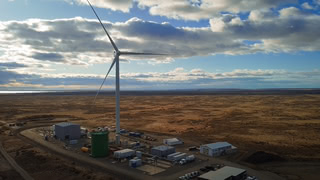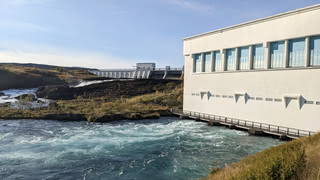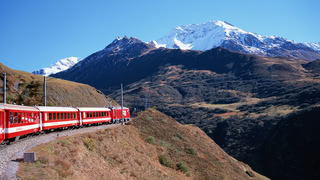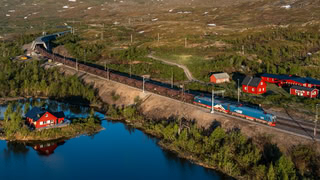Iceland's E-Fuels Controversy
Hydrogen and E-Fuels companies want to utilize Iceland's abundant renewable energy sources. But Iceland's largest energy company Landsvirkjun does not want to sell electricity to them. E-Fuels producers hope that European authorities will intervene, the EFTA Surveillane Authority investigates.

Could Iceland's rich renewable energy sources make it the perfect place to produce green Hydrogen and Hydrogen-derived E-Fuels? Several companies think so, but Iceland's state-owned power company, Landsvirkjun, rejected requests from these companies to supply them with electricity. Landsvirkjun is Iceland's largest electricity producer.
While Landsvirkjun says it is currently unable to supply electricity to such projects due to supply constraints and a slow buildout of new electricity production, its potential customers question whether the electricity company is even allowed to reject them. VOR, a lobbying organization for the Hydrogen and E-Fuels producers, has filed a complaint with the EFTA Aurveillance Authority, which is now investigating the issue.
Iceland is one of the few countries that already operates its entire electricity system on renewable energy. The country exclusively uses hydropower and geothermal energy. Iceland's electricity system is unique not just because it is powered by renewable energy but also because it produces a lot of electricity.
Due to its favorable conditions, the country has attracted industries that need large amounts of cheap electricity. Three aluminium smelters and production plants for silicon and ferrosilicon consume most of Iceland's electricity.
Iceland's strategy to attract these investments with cheap, clean energy, and how that strategy came to a sudden halt due to a controversial hydropower project, is a fascinating story on its own, and one that I may cover in more detail in the future.
Iceland still has plenty of potential to increase its electricity production. Estimates from the 1990s assume that using all of Iceland's hydropower and geothermal potential could add up to 50 Terawatt hours annually, more than twice what is produced today (around 20 TWh). Those old estimates do not include wind energy, which Iceland currently does not use in meaningful quantities.
It is, however, unlikely that Iceland will increase its renewable electricity production to its full potential. That would involve many controversial construction projects that would likely not be accepted by the population. In recent years, Iceland's power companies have only slowly expanded electricity production.
Importing Green Hydrogen and E-Fuels from places with lots of Renewables
In recent years, Green Hydrogen has played a major role in the climate and energy debate. A recurring theme is the idea that Hydrogen and its derivatives could serve as future energy carriers. Countries importing fossil fuel energy today could switch to importing clean energy carriers, produced in regions with abundant renewables.
While it is an appealing idea, it comes with considerable challenges. Hydrogen is incredibly difficult to transport, and real-world clean Hydrogen prices are much higher than price estimates in hypothetical Hydrogen strategies.
Transporting Hydrogen molecules over long distances is impractical due to high costs, boil-off effects, and inefficiencies. It is more practical to transport molecules made from Hydrogen, like E-Fuels. E-Methanol could serve as a shipping fuel, airplanes could be powered by E-SAF.
Countries like Australia or Chile are often named as potential exporters of such clean energy carriers. While these countries certainly have the potential to become clean energy superpowers, they still produce plenty of electricity from fossil fuels today for their own needs. Using renewable energy to clean up their own grids will have a bigger impact on emission reduction.
It is, therefore, not surprising that Iceland looks like an attractive place to produce Hydrogen and E-Fuels. The country is already powered by 100 percent renewable electricity and has the potential for expansion. (Saying that Iceland is powered by 100 percent renewable electricity ignores the questionable sale of green electricity certificates from Iceland, which I have covered in detail before.)
Not many great CO₂ sources in Iceland
Making E-Fuels requires not just large amounts of green electricity, it also requires carbon dioxide. However, finding suitable carbon dioxide sources in Iceland could be challenging.
Iceland's largest carbon dioxide emitters are the aluminium smelters. While aluminium production is largely powered by electricity, the process also involves carbon anodes. Those are consumed and turned into carbon dioxide in the process and are usually made from petcoke, a by-product of petroleum refining, and, therefore, a fossil fuel.
It is doubtful whether E-Fuels derived from fossil carbon dioxide emissions should be considered green. EU regulation allows it under certain conditions, but only for a limited time.
The production of silicon and ferrosilicon also generates carbon dioxide. They use a mixture of fossil carbon sources and wood chips as reducing agents. Silicon and ferrosilicon plants could run entirely on biogenic carbon sources, and there are not many alternatives to reduce their emissions. Therefore, using carbon dioxide from those plants for E-Fuels production may be less controversial if they are converted to fully biogenic carbon in the future. (Converting aluminium anodes to biogenic carbon is more challenging and there are competing solutions like inert anodes or chlorine-based aluminium production.)
Neither aluminium nor silicon and ferrosilicon are particularly great targets for carbon capture technology. Especially aluminium production has an extremely low CO₂ concentration in its flue gas, which makes carbon capture expensive. The CO₂ concentration is slightly higher in silicon and ferrosilicon production but still low.
Norwegian research institution SINTEF has experimented with recirculating silicon smelter exhaust gases in order to increase the CO₂ concentration, and similar ideas have been proposed for aluminium. Yet, those technologies are untested on an industrial scale.
Iceland's geothermal plants also generate carbon dioxide. Carbon Recycling International, the early E-Methanol pioneers of E-Methanol production, used CO₂ from a geothermal plant in their pilot plant in Iceland. However, the volumes are not huge, and claiming that E-Fuels made from geological carbon dioxide are green is certainly questionable.
Iceland's largest geothermal plant, Hellisheiði, is already using carbon capture and storage to avoid its emissions. Carbon dioxide and Hydrogen sulfide, another unwanted gas from geothermal plants, are reinjected into the ground by the company Carbfix. Carbfix just announced that it received a permit for increased CO₂ injection: "With the permit in place, it is now possible to capture and store all CO₂ emissions of the Hellisheiði Power Plant."
Permanently storing and mineralizing Hellisheiði's emissions is probably a better idea than turning them into E-Fuels. However, another Carbfix project could potentially help companies source carbon dioxide. The company plans to build a CO₂ import terminal.
Another potential CO₂ source is direct air capture. Climeworks operates the world's largest direct air capture plant right next to the Hellisheiði power plant. However, even with Iceland's cheap green energy, direct air capture is excessively expensive.
Given these challenges of sourcing suitable CO₂ in Iceland, what do companies planning to produce E-Fuels have in mind? Carbon Iceland, a company planning to produce E-Methanol, wants to utilize carbon dioxide from the Norðurál aluminium smelter, despite the difficulties with capturing CO₂ from such plants.
IðunnH2, a company that plans to produce E-Fuels for aviation (E-SAF), plans to import its own carbon. It wants to use gasification of biochar combined with green Hydrogen to make Methanol, which would be a combined Bio-E-Methanol process.
IðunnH2 plans to use technology from Carbon Recycling International for Methanol synthesis and from Honeywell for the subsequent Methanol-to-Jet-Fuel process. An intermediate step of the latter is Honeywell's Methanol-to-Olefins process, which can also be used to make plastics.
Yet, all those plans rely on green Hydrogen, which requires plenty of electricity.
Landsvirkjun was already looking into E-Methanol in 2011
Long before the Hydrogen hype in recent years, Landsvirkjun was toying with the idea of producing Hydrogen-derived Methanol. In 2011, Landsvirkjun and Carbon Recycling International were investigating the feasibility of a large E-Methanol plant in Iceland. But that didn't happen.
Landsvirkjun has also showen interested in such projects in recent years. In March 2022, the company was exploring the possibility of using carbon dioxide from PCC's silicon plant in Iceland to make E-Methanol.
Two months later, in June 2022, Landsvirkjun posted a statement from its CEO Hörður Arnarson on its webpage. The document says a lot about the mindset of the company. Landsvirkjun is quite opinionated about its customers.
Landsvirkjun-CEO Arnarson writes that there is more demand for electricity in Iceland than supply and that "Landsvirkjun must prioritise energy sales to certain groups of consumers for the coming years."
Existing customers, including existing industrial plants, are given priority. The development of digital services and data centers is seen as a priority, but explicitly not the mining of cryptocurrencies (like Bitcoin).
Landsvirkjun's CEO lists demands that are currently not a priority for the company: new industrial customers from the metal industry and exports of energy. He explicitly mentions "the option of exporting energy in the form of e-fuel or by submarine cable." (Iceland's electricity grid is not connected to other countries. Plans in the past for a grid connection with the European mainland have not been realized.)
Landsvirkjun further emphasized its skeptical approach to E-Fuels in a statement published in April 2025: "We do not anticipate hydrogen and e-fuels playing a major role in Iceland's domestic energy transition in the near future, although this could change over the next decade or later. The cost of green hydrogen and e-fuels remains high compared to fossil fuels or to alternative energy transition options, such as direct electrification or bioenergy."
While Landsvirkjun says it may supply electricity to smaller Hydrogen projects, the company current does not want to supply electricity to larger projects. The company argues that it wants to supply electricity to projects that "contribute to reducing greenhouse gas emissions" and that this goal is better served in other areas: "Direct electrification in mobility and industry represents a key energy transition pathway that aligns well with these objectives."
Landsvirkjun makes an interesting point. Even in places with plenty of renewable electricity, it is well worth asking what to do best with it — and where to achieve the largest emission reductions.
Unsurprisingly, potential Hydrogen and E-Fuels producers in Iceland are not happy about this strategy. They are raising the question whether Landsvirkjun's "opinionated" approach to customers is even allowed under European free trade rules.
Iceland is part of EFTA, the European Free Trade Association. It includes four European countries that have close ties to the European Union but are are not part of it. Together, the EU and the EFTA countries Iceland, Norway, Switzerland, Liechtenstein form the European Economic Area (EEA). That involves many shared regulations that govern markets and trade within the EEA. The EFTA Surveillance Authority (ESA) oversees compliance with the EEA rules in Iceland, Norway, and Liechtenstein.
Recently, both Landsvirkjun and the EFTA Surveillance Authority informed the public that a formal investigation against Landsvirkjun has been initiated. ESA must have prepared this decision for multiple months, as Landsvirkjun writes that it received a request for information from ESA in June 2024.
"ESA has decided to formally open an investigation into whether Landsvirkjun has infringed EEA competition rules by refusing to supply electricity to enterprises seeking to produce hydrogen or e-fuel in Iceland. Such practices could be anticompetitive." ESA writes in its press release. "The investigation will look at if Landsvirkjun's practice concerning the negotiation and potential conclusion of long-term power purchase agreements and its criteria for selecting potential customers infringe EEA competition rules, in particular Article 54 of the EEA Agreement, which prohibits abuse of dominant position."
Hydrogen and E-Fuels Association VOR filed a complaint
ESA does not mention who launched the complaint, and Landsvirkjun explained to me in an e-mail that a company under investigation is not informed about who filed the complaint. But I learned in background conversations that it was initiated by the Icelandic Hydrogen and E-Fuels Association VOR (Vetnis- og rafeldsneytissamtökin). The already mentioned companies, Carbon Recycling International, Carbon Iceland, and IðunnH2, are all members of VOR.
In its press release, Landsvirkjun calls the decision by the EFTA Surveillance Authority a surprise, and writes: "The reason it has not been possible to sell electricity to e-fuel projects is the very high utilization of the system and Landsvirkjun has, in recent years, had to decrease delivery of both capacity and energy to existing customers with curtailability clauses in their contracts. Similarly, delays in the permitting process for new power plants have made it challenging to support many new projects."
Landsvirkjun argues that it cannot expand electricity production fast enough to serve all needs. Given Iceland's past controversies about expanding power production, that appears unsurprising, and complaints about slow permitting processes are certainly often part of new cleantech projects.
ESA's decision mentions an interesting additional aspect: "The refusal to supply electricity to hydrogen and/or e-fuel producers might also protect Landsvirkjun's own electricity generation activities in the upstream market, since a refusal to supply balancing power may hinder the establishment and operation of large-scale wind power facilities that are independent of Landsvirkjun."
As mentioned, wind energy is currently not a significant part of Iceland's electricity production. The number of wind turbines in Iceland is two. However, there is plenty of wind in Iceland.
As everyone will be aware of, the wind does not always blow. Balancing variable renewable energy sources like wind is a challenge. However, in places with plenty of hydropower, existing flexibility in hydropower plants can be used to complement variable sources.
It appears ESA is concerned that Landsvirkjun may hinder potential competitors by refusing to support wind energy with its hydropower. Landsvirkjun wants to use wind energy itself, but they are not the only ones. Another wind power developer is the French company Qair, which writes about its activities in Iceland: "we are the largest wind power plant developer in the country with a pipeline of over 780 MW." Qair is also a member of VOR, the Icelandic Hydrogen and E-Fuels Association.
Even if Landsvirkjun eventually accepts Hydrogen and E-Fuels companies as customers, they may not be happy with the prices they would have to pay, a person familiar with the issue told me in a background conversation.
Offering very low electricity prices to aluminium producers and other industries was, in the past, a political decision in Iceland. It is unclear whether Hydrogen and E-Fuels producers would receive the same discounts. (This echoes similar debates in Sweden, where steel company LKAB was unhappy about the electricity prices Vattenfall offered for Hydrogen-based green steel projects. Vattenfall indicated that with a substantial expansion of wind power, the company would not be able to offer the very low electricity prices common in Sweden's northern region.)
It will be interesting to watch how the controversy between Landsvirkjun and the potential E-Fuels producers will progresses and whether or when we will see large-scale E-Fuels production in Iceland. Both Landsvirkjun and the EFTA Surveillance Authority emphasize that no infringement of EEA rules has been found yet. "The decision means only that ESA will proceed with an in-depth investigation," the EFTA Surveillance Authority writes.
Update: Shortly after this article was published, Landsvirkjun announced that it has put its E-Methanol project with PCC on hold.
Author: Hanno Böck
Brief
-
Capturing CO₂ from low-concentration sources is difficult, which makes carbon capture at sources like gas power plants very expensive. Oxyfuel power plants could help address this. NET Power from Texas operates a small oxyfuel pilot plant with its Allam Cycle turbine technology and is currently building a larger one. Yet, NET Power had plenty of difficulties lately. The plant has been delayed, costs have increased, and NET Power's stock price plummeted in recent months. (I had previously covered NET Power's Allam Cycle turbine as part of an idea to use Methanol for long-duration energy storage.)
-
Recently, I mentioned the world's largest operational battery-electric ferry, the Bastø Electric in Norway. It transports up to 600 passengers over a distance of around 10 kilometers. Things are moving fast in the world of battery-powered ships. Shipmaker Incat announced the completion of the battery-electric China Zorilla, or Hull 096. It can transport up to 2,100 passengers and will operate on a route between Argentina and Uruguay around 50 kilometers long.
-
Evidence is piling up that a significant share of "second generation" biofuels sold in the EU, supposedly made from biogenic waste, are actually made from virgin palm oil. Indications for widespread fraud have been known for some years. According to media reports, the European Commission is considering the suspension of certifications from ISCC, one of the most important bioenergy certification schemes. According to German television station ZDF, Cian Delaney from the NGO Transport & Environment estimates that the EU imported more than twice the volumes of Palmoil Mill Effluent (POME), a waste product from food palm oil production, than what the world market could plausibly provide.
-
The research project GreenFeed, a collaboration of German universities and research institutions, has published its final report (unfortunately, only available in German). It has investigated alternative feedstocks for the European chemical industry. Notable results include that the scenario assumes very high rates of circular feedstocks due to chemical recycling and a significant shift away from steam crackers towards methanol-to-olefins and methanol-to-aromatics technology.
-
Speaking of steam crackers and chemical recycling: Dow plans to close down its cracker in Böhlen (Germany). This likely also marks the end of plans Dow had in collaboration with UK company Mura to build a large chemical recycling plant in Böhlen.



